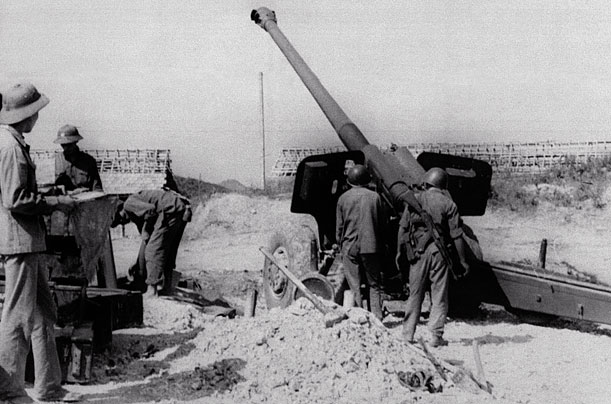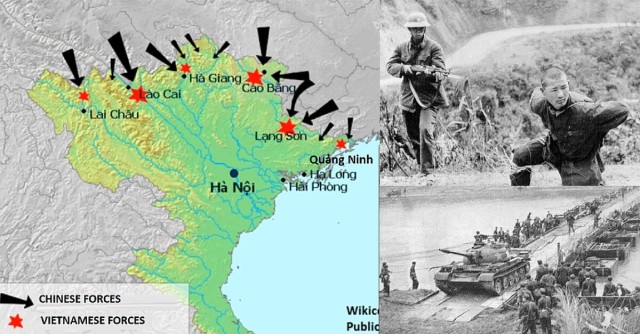In 1979, China invaded Vietnam because Vietnam had invaded Cambodia, whose rulers were backed by China. The conflict lasted a month and resulted in tens of thousands of casualties. The Chinese army withdrew from Vietnam but despite this, China claimed a victory.
To understand this, we have to go back in time and further north. China and Russia used to be friends, so when the Vietnam War broke out in 1955, they supported the communist North against the capitalist South. By the time it ended in 1975, however, the Chinese and the Soviets were at each other’s throats.


The Soviets were exhausted from decades of war, so they wanted peace with the West. But Mao Zedong (China’s leader) wanted a more aggressive approach toward “decadent” capitalist nations, which is why he attacked Taiwan from 1954 to 1955, and again in 1958.
The US went to the Taiwan’s aid, but the Soviets didn’t want to get involved. This angered Mao. Then in 1959, the Soviets offered moral support to Tibetan rebels after the latter’s failed uprising against China. The following year, Mao and Soviet Premier Nikita Kruschev were yelling at each other at the Romanian Communist Party Congress. Still, they needed each other, so they kept their alliance.
Then came the Cuban Missile Crisis of 1962. With the world’s focus on Cuba, China invaded and occupied India’s Aksai-Chin province. And what did the Soviets do? They withdrew their missiles from Cuba and sold weapons to India. For Mao, that was the last straw. Soviet capitulation to the US was bad enough, but what kind of ally sells weapons to your enemies? Sino-Russian relations took a nose dive.
By 1969, they were having skirmishes along their borders. Realizing he couldn’t confront the Soviets and the Americans at the same time, Mao began wooing the Americans. It worked. President Richard Nixon visited China in 1972 and reestablished diplomatic ties.
The Chinese and the Soviets were now engaged in their own Cold War within the communist world. In 1975, Vietnam and Laos sided with the Soviets, so China reached out to Cambodia. Mao died in 1976, but the Sino-Soviet Cold War continued.
Vietnam and Cambodia had had border skirmishes since 1975, so the Vietnamese decided to end it once and for all. On 3 November 1978, they signed a 25-year mutual defense treaty with the Soviets, then invaded Cambodia on December 25. By 7 January 1979, they took the capital at Phnom Penh and drove the Khmer Rouge out.
With the Soviets to their north and the Vietnamese to their south, the Chinese felt trapped. China (now under Deng Xiaoping) visited the US on January 1 and told President Jimmy Carter that Vietnam needed to see a show of force to prove that China could protect her client states.
The next day, he told Moscow that China was ready for a war with Russia. To prove it, some 300,000 Chinese civilians were evacuated from the Sino-Soviet border, while the People’s Liberation Army of China (PLA) were massed along its length.
For justification, Deng claimed that ethnic Chinese were being mistreated in Cambodia and that Vietnam’s occupation of the Spratly Islands was illegal since it was Chinese territory. With hundreds of thousands of PLA forces massed on the Sino-Vietnamese border, a “limited invasion” was declared on February 15.
On February 17, General Xu Shiyou ordered 200,000 soldiers into Vietnam in 26 teams from west to east. Their goal was to take the northernmost Vietnamese provinces of Lai Châu, Lào Cai, Hà Giang, Cao Bằng, Lạng Sơn, and Quảng Ninh.
But the Vietnamese were ready. The Chinese had been saber-rattling along their border since January, so they evacuated their northern towns and cities, let the Chinese advance, and then picked them off with guerilla tactics.
The Chinese had counted on superior numbers, but it didn’t help. Much of their equipment was outdated, and few had any war experience. Many of the Vietnamese, however, were war veterans with some of the weapons and equipment the Americans had left behind.
Russia had also given them 400 tanks, 800 anti-tank missiles, 400 surface-to-air missiles, and 20 jet fighters (but these were mostly used for reconnaissance). They also had between 5,000 and 8,000 Russian “military advisers,” while 15 ships of the Soviet Pacific Fleet were off the Vietnamese coast decoding Chinese communications.
To make sure the remaining PLA troops didn’t cross over, the Soviets deployed their military along both the Sino-Soviet border and the Mongolian-Chinese border. Faced with the possibility of an additional battle-front, China kept its reserve force back. The PLA wanted to draw the People’s Army of Vietnam (VPA) out into open combat, but the Vietnamese would not take the bait.
Meeting the Chinese were local militia forces of about 100,000 focused on four locations: (1) at Lạng Sơn on Highway One – the traditional Chinese invasion route into Vietnam, (2) the northwestern coast along Haiphong, (3) the Red River, which leads to Hanoi, and (4) the Black River, which also leads to Hanoi.
The 26 Chinese attack prongs began joining up into larger groups, but except for tank battles, they rarely saw their enemies. By the end of February, the VPA still hadn’t committed most of their regular divisions, but their largely guerilla tactics had ground down the Chinese. By early March, most of the fighting was limited to Lào Cai, Cao Bằng, and Lạng Sơn.
Deng never intended to occupy Vietnam. He wanted to: (1) scare the Vietnamese out of Cambodia, (2) do it quickly to avoid outright conflict with the Soviets and avoid alienating the West, (3) show that Russia couldn’t protect its friends, (4) demonstrate Chinese military might, and (5) prove to the communist bloc that they made better allies than the Soviets.
But they weren’t making any headway. To save face, Deng claimed that the PLA had cleared the way to Hanoi, so their objectives had been met and they could withdraw. They did so on March 6th and destroyed what remaining local infrastructure they could. Buildings, houses, railroads, and communication infrastructure were all destroyed, further impoverishing northern Vietnam. Ten days later, there were no more Chinese in Vietnam.
Having expelled the Chinese, Vietnam also declared a victory. No one really knows how many died. It’s estimated that Vietnam lost some 26,000 to 60,000 people, while China lost between 6,954 and 50,000. Sino-Vietnamese skirmishes continued till 1989 when Vietnam finally pulled out of Cambodia.
When the Vietnamese think of war, they think of China first, and America second.


Leave a Comment